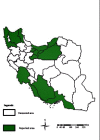New Data on Latrodectus tredecimguttatus Rossi, 1790, the Medically Important Spider Species (Araneae: Theridiidae) from Iran
- PMID: 34223736
- PMCID: PMC8410189
- DOI: 10.22092/ari.2020.341960.1446
New Data on Latrodectus tredecimguttatus Rossi, 1790, the Medically Important Spider Species (Araneae: Theridiidae) from Iran
Abstract
Spiders are one of the most important orders of Arachnida comprising more than 48,000 species in the world. Except for families Uloboridae and Holarchaeidae, all others are classified as the venomous spider. However, only about 200 species are medically relevant and cause public health problems or even death. In Iran, there are 51 families and 763 species of spiders, of which the families, Theridiidae and Sicariidae are dangerous for the human being, and the first one is more prevalent. The Latrodectus is considered one of the most poisonous spiders in the world and Iran. This genus has five species in Iran, among which Latrodectus tredecimguttatus (black widow spider or “Dolmak”) is considered one of the most poisonous spiders in Iran. Therefore, this study aimed to investigate this species in the Northwest of Iran (West Azerbaijan, East Azerbaijan, and Ardabil provinces, Iran). Spatial distribution maps were prepared using GIS 9.4. In the current study, five adult female spiders were collected from Germi and Ardabil cities (Ardabil Province), Ahar County (East Azerbaijan province), and Urmia city (West Azerbaijan province) of Iran. These species were first observed in Ardabil province, Iran. Therefore, the presence of Latrodectus species under the rocks in wheat farms in this corner of Iran may be a threat to farms and visitors. People in these areas should wear gloves and avoid any activity that disturbs the spiders and make them aggressive.
Keywords: Araneae; Iran; Latrodectus tredecimguttatus; Theridiidae.
Copyright © 2021, Author(s). Published by Kowsar.
Figures
References
-
- ReferencesAfshari R, Khadem-Rezaiyan M, Balali-Mood M. Spider bite (latrodectism) in Mashhad, Iran. Hum Exp Toxicol. 2009; 28: 697–702. - PubMed
-
- Cesaretli Y, Ozkan O. A clinical and epidemiological study on spider bites in Turkey. Asian Pac J Trop Med. 2011; 4: 159–162. - PubMed
-
- Dehghani R. Venomous Animals; Are They Important in Iran. Int Arch Health Sci. 2015; 2: 167–169.
-
- Dehghani R, Talaee R, Rafeenejad J, Rezvani SR, Karimi F. Brown widow spider bite (Loxosceles sp. , Araneae, Sicariidae): A case report from Kashan, Iran. Iran J Dermatology. 2017; 20: 32–35.
-
- Diaz JH. The Global Epidemiology, Syndromic Classification, Management, and Prevention of Spider Bites. Am J Trop Med Hyg. 2004; 71: 239–250. - PubMed
Publication types
MeSH terms
LinkOut - more resources
Full Text Sources


